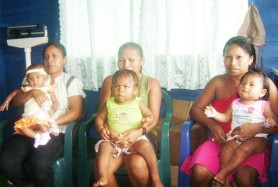As mercury in mining comes further under the microscope, awareness of its improper use and consequential effects on human health has seen residents of the village of Isseneru, Region Seven (Cuyuni/Mazaruni) using alternatives to fish.

In 2002, the Canadian International Development Agency (CIDA)–funded Guyana Environmental Capacity Development Project (GENCAPD), published findings of studies conducted at Isseneru and Kurupung, also in Region 7, and following comparisons made between the two areas, results showed that 89-96% of the population surveyed in Isseneru had dangerous levels of mercury contamination as examined by its presence in human hair. The study also found that fish consumption at Isseneru was higher (3-4 times/week) as compared to Kurupung (2-3 times/week).
Studies have shown that fish absorb methyl mercury from water as it passes over their gills and as they feed on aquatic organisms. In addition findings have also indicated that the larger predator fish are exposed to higher levels of methyl mercury from their prey.
The substance binds tightly to the proteins in fish tissue including muscle. Studies also indicate that cooking does not necessarily reduce the methyl mercury content of the fish.
During a recent visit to Isseneru, Stabroek News was informed by residents there that they have been using alternative sources of protein as well as adapting to the use of other foods such as cassava and plantains as opposed to fish.
They said concerns were raised over the past few years on the use of mercury by gold mining operations in the area, as they noted that fish plays a major part in their daily meals.
Chief Medical Officer, Dr Shamdeo Persaud, who visited the community while this newspaper was there, said that the programme, which is a collaborative effort between the Ministry of Health and GENCAPD, targets pregnant mothers in the area following research conducted in the community. He said that the health ministry has been carrying out surveys over the past three years as well as clinical examination of the population at Isseneru.
Persaud said that fish consumption in the community was modified, based on recommendations, which means that persons do not necessarily have to stop consuming fish.
He went on to say that research was also conducted at Aishalton and Gunn’s Strip in Region 9 and findings showed that there were high levels of mercury present in person’s bodies in those non-mining communities. He said this points to the fact that participants in the study in those communities could have only absorbed mercury through fish intake.
At the moment, the CMO stated, the health ministry is working on the project at identified areas where mercury is used, primarily in mining areas.
He noted that there are also cases in which persons involved in the amalgamation processing of gold, such as goldsmiths, in which mercury is used, have high levels of the substance in their systems.
He said that there exists a public awareness programme where the issue is being brought to the fore in remote/mining areas via the services of community health workers which he noted is important since those persons play a vital role in educating residents in those areas of the effects of mercury use on the environment.
He noted that studies were also conducted in 2007 and 2008 but the findings for the former had been destroyed by the recent fire at the ministry’s offices in Brickdam, Georgetown, while the latter is still being examined.
Great use
Evadney Cleto, a mother of a seven-month-old baby girl and a participant in the programme, told Stabroek News that the project is of great use, stating that she had been paying attention to her fish intake. She said she had been avoiding the large fish such as the Haimara and Basha and she has since been using the smaller species of fish such as the patwa and sunfish. Cleto, who has been living at Isseneru over the past four years, related that health teams from the Ministry of Health often visit the area on outreaches which focus on, among other health issues, the mercury programme. She said she believes the outreach efforts are ‘good’, noting that she and the members of her household have made a few adjustments to their ‘meat use’ in which chicken and beef now enter the picture. She said she intends to stick to her schedule as long as possible.
Two other participants in the programme, Anthlee Jacobs and Sharmin Jones echoed similar views noting that they have recognized the consequences which the improper use of mercury in nearby mining operations may have on the environment.
Scientific consultant attached to CIDA, Richard Couture, told Stabroek News that 95% of the success of the progamme may come from pregnant mothers. He explained that mercury may not pass from mother to child by breast feeding but rather via the placenta. He said based on findings to date, there is no evidence to suggest that presence of mercury in persons locally has reached a pandemic stage. Couture noted that the current programme is more precaution –based, noting that at the community of Micobie, in Region 8 (Potaro/ Siparuni), results have been better when compared to Isseneru, which he notes, is the result of changes in diet.
There have been a number of concerns about the unhealthy effects mercury use in mining operations may have on persons living in nearby communities and President Bharrat Jagdeo, at a forum last week in which he met with miners to discuss a range of issues affecting the mining sector, stated that the use of the substance in mining operations will soon come to an end.





